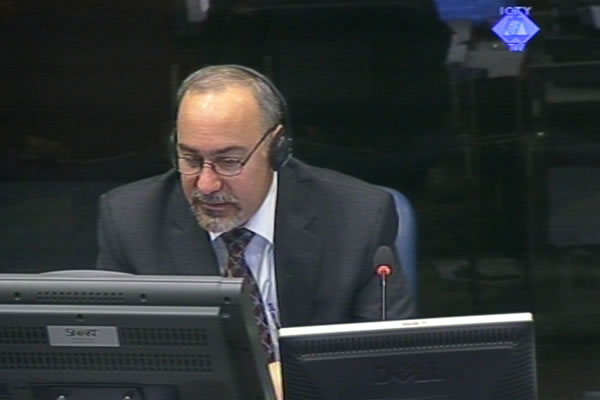Home
WITNESS: KARADZIC WAS KEPT INFORMED ABOUT EVERYTHING
In the first part of his evidence, Richard Butler confirmed that Radovan Karadzic was in command of the army and police and that he issued directives containing political and military guidelines for the war. Butler also confirmed that Karadzic was kept well-informed about the course of the military operations including Operation Krivaja 95 in July 1995. The former supreme commander of the Republika Srpska armed forces is charged with crimes perpetrated in that operation
 Richard Butler, witness at the Radovan Karadzic trial
Richard Butler, witness at the Radovan Karadzic trial The trial of Radovan Karadzic continued with the evidence of Richard Butler, an officer of the US National Security Agency and former OTP military intelligence analyst. From April 1997 to November 2003, Butler worked in the Srebrenica investigation team, examining military, police and other documents which were believed to be related to the crimes committed by the Serb forces in Srebrenica. Butler also interviewed a number of witnesses and analyzed intercepted conversations between various Republika Srpska political and military leaders.
In the first part of the examination-in chief, Butler confirmed that Karadzic commanded the Republika Srpska army and police, issuing directives containing political and military guidelines for the war. The VRS Main Staff and the subordinate corps worked in concert with the police to implement them. Butler also confirmed that Karadzic was kept well-informed about the course of the operations, including Operation Krivaja 95 in July 1995.
In Butler’s words, the Serb leadership was aware as early as in 1992 that there were more Muslim than Serb inhabitants in the area of responsibility of the VRS Drina Corps in Eastern Bosnia. This situation resulted in Directive 4, which gave rise to operations aimed primarily at cleansing the area of Muslim civilians. The goal was eventually accomplished: some of the people fled northwards to Tuzla and the rest poured into the area around Srebrenica.
In the following period, the goal of the VRS remained the same, Butler explained. Karadzic’s Directive 7 from March 1995 didn’t call for an all-out military attack on Srebrenica and Zepa, as this was considered to be too provocative because the enclaves were under protection of the UN. The Serb leadership then decided to create a situation in which the UN would leave the protected zones or the people would put pressure on their leadership to get them out of the enclave, Butler recounted.
In the witness’s opinion, there is no difference between Karadzic’s Directive 7 issued on 8 March 1995, ordering the creation of ‘unbearable conditions’ in Srebrenica and Mladic’s version of the same directive of 31 March 1995 in which this sentence is missing. Butler claimed that Mladic’s Directive 7.1 merely provided ‘technical explanations’ of the same goals. This is corroborated by the order to launch Operation Krivaja 95 in which the Drina Corps commander, General Zivanovic, referred to both documents.
The prosecutor brought up an intercepted conversation between Karadzic and Zivanovic on 6 July 1995. In the conversation, the RS president enquired about the advancing of the Serb troops towards Srebrenica; he asked Zivanovic, ‘have we taken Sise (the Teats)?’ Karadzic meant three strategically vital locations in the Zeleni Jadar area. This conversation showed that Karadzic was involved in the operation and had detailed information about its implementation, Butler said. In the conversation, Karadzic promised Zivanovic that he would secure police support for him. The prosecutor then showed documents that indicate Karadzic kept the promise.
Prosecutor Nicholls brought up a ‘situation map’ of the Srebrenica operation on which Mladic jotted down the words: ‘Finished. This is and will remain a Serb area’ on 12 July 1995.
Richard Butler’s testimony will continue tomorrow.
Linked Reports
- Case : Karadzic
- 2012-04-12 AMERICAN SERB’S DISBELIEF
- 2012-04-11 KARADZIC: ‘EVERYBODY AND HIS UNCLE ABNER IS EAVESDROPPING ON ME’
- 2012-04-10 KARADZIC CONTESTS NUMBER OF SREBRENICA VICTIMS
- 2012-04-18 KARADZIC’S INTERCEPTED COMMUNICATIONS REMAIN IN EVIDENCE
- 2012-04-18 BUTLER: ‘OPERATION TO KILL’ IN SREBRENICA
- 2012-04-19 KARADZIC WANTS THE DIRECTIVES TO BE INTERPRETED ‘IN THE SPIRIT OF THE SERBIAN LANGUAGE’
